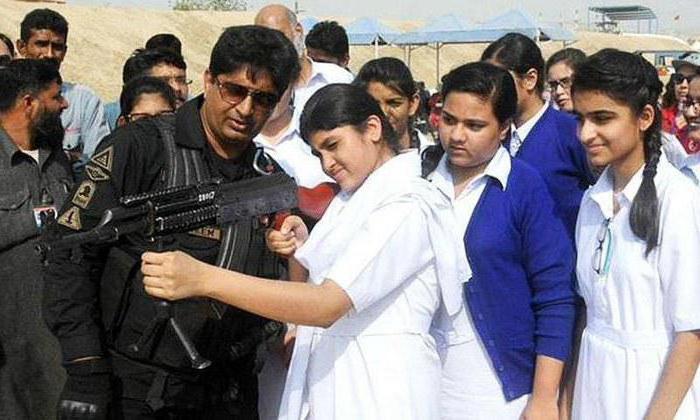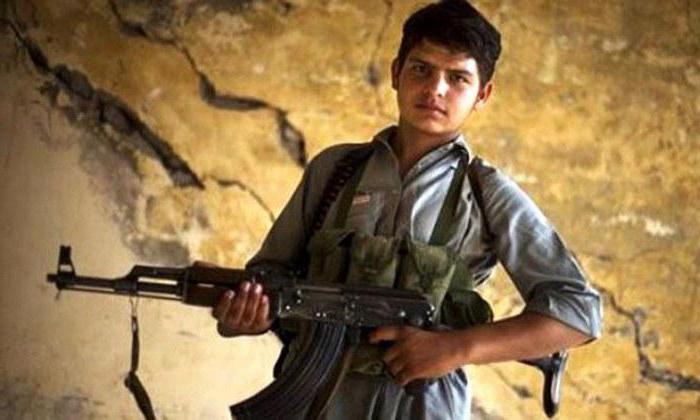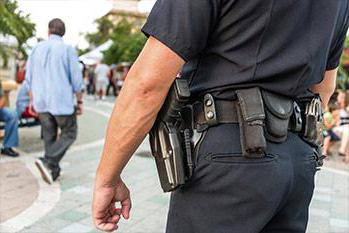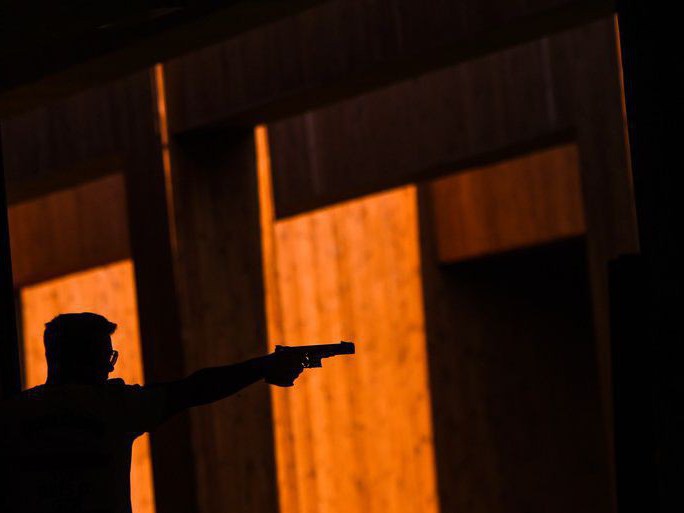The use of physical force, special means and weapons by officials and citizens, including members of the Armed Forces, is regulated by the Charters, Federal Laws and other legal documents. In normative acts there is an indication of the presence of emergency. In particular, the UVS is talking about this (article 13). The use of weapons is considered a last resort. Let us further consider in detail the situations in which this is permitted by current regulations. 
General information
Criminal law stipulates the use of weapons. This measure can be used when detaining a criminal or in emergency situations. Meanwhile, as analysis of the norms shows, the procedure for using weapons established by Art. 13 airborne forces, defines a number of restrictions for situations that formally fall under the necessary defense.
Repel an attack
The use of firearms by police is allowed if there is a threat to the protected objects. These include, among other things, the locations of units and military units, convoys of vehicles, trains, structures and buildings, single vehicles and guards. An attack can be either armed or unarmed group. By the form of action, by its reflection it is regarded as a necessary defense. Meanwhile, an armed attack has a threat to life. Its presence, in accordance with Art. 37, part 1 of the Criminal Code, allows you to cause any harm to the subject encroaching on the above objects. Moreover, an unarmed group attack is not associated with a direct threat to life. According to the criminal law, in such a situation, death is not allowed as lawful harm. Accordingly, the use of weapons by military personnel may be permitted after assessing the proportionality of the potential harm and the damage caused in response. 
Suppression of the illegal seizure of equipment and ammunition
In this situation, there is a defense of the object. Regarding this condition, it is quite possible to apply the above argumentation. Military equipment and ammunition are considered less valuable than human life. In this situation, the sign of proportionality of the probable and the damage caused does not coincide with the criminal law criterion.
Attack defense
The use of firearms by the police is allowed if there is a threat to the life or health of citizens, both civilians and those in the armed forces. At the same time, it should be stated that it is impossible to protect the specified persons by other means. The necessary defense conditions cover this situation, if we exclude a threat to health from it. It does not allow defensive actions aimed at causing death. Present in this provision, an indication of other ways to provide protection limits the legitimacy of the necessary defense, which are primarily provided for in art. 37, part 1 of the Criminal Code. According to experts, the addition of the phrase “if protection is not possible by other means” is legally redundant. 
Detention
The use of firearms is permitted in relation to the subject, which provides resistance. In this case, one condition must be fulfilled. The subject must provide armed resistance. Officials may detain a citizen who refuses to fulfill their requirements. A pistol, machine gun, etc. can be used if a citizen is armed and does not want to surrender weapons voluntarily.This situation is by all indications outwardly similar to the detention of the subject who committed the crime.
The very fact of illegal armament and resistance can be qualified as a criminal offense. According to Art. 38 of the Criminal Code, the purpose of detention is the delivery of a citizen to specially authorized bodies (law enforcement) and the suppression of the commission of new crimes by this subject.
In the sense of the norm, causing death is not allowed under any circumstances. A deeper analysis reveals that armed resistance, which has been detained by a person since the start of opposition to law enforcement officials, is transformed into an assault. It contains a threat to the life of an official. Accordingly, a necessary defense condition arises. Moreover, the possession of a weapon by a detained person, even if he does not use it at the time of suppression of his actions, can be considered a sufficient basis for appropriate retaliatory actions that could lead to his death. 
Other situations
In Art. 14, part 2 of the fire department provides for other cases of the use of weapons. For example, it can be used to call for help or give an alarm, as well as to scare away an animal that poses a threat to human health or life. Norms allowing such situations are present in federal laws.
Bans
They are established in Art. 14, part 4 of the UVS. In accordance with the norm, the use of weapons in relation to:
- Juveniles when age is known or obvious.
- Women.
- Citizens with clear (external) signs of disability.
The exception is situations when these persons carry out a group or armed attack that poses a threat to other persons. The use of weapons in such cases is allowed if it is not possible to eliminate the danger posed by them by other means.
In contrast to Art. 28, part 3 of the Federal Law governing the activities of internal troops, a number of provisions are missing from these prohibitions. In particular, there is no indication of the armament of resistance and the non-use of weapons with a large concentration of citizens. Meanwhile, for the sake of completeness of the analysis, it must be said that the above exceptions, which cancel the prohibitions, cannot cover the whole breadth of situational diversity, when the threat to life during the encroachment of disabled people, women and minors can manifest itself in others other than those established in Art. 14, part 4 of the UVS forms. This, in turn, means that the military has the right to use weapons against these entities in situations that go beyond the limits provided for in the norm. In this case, there must be a danger to life during their attack in any other form. 
The procedure for using weapons
General provisions are provided for in parts 1 and 2 of Art. 13 air-blast. The rules for the use of weapons established in them give officials certain powers. It is allowed to realize them in the process of fulfilling their direct duties. Moreover, in cases of emergency it is allowed to use weapons outside the working hours. In addition, the general provisions set forth the requirements regarding its wearing and storage. The procedure for using weapons is also determined in federal law. The established provisions do not correlate with the circumstances which exclude the criminal act. However, they put a person outside the scope of criminal prosecution when revealing the facts of carrying and storing weapons, if an official acts as a defendant.
Order or decision of the commander (chief)
In h. 3 Article. 13 UVS contains the procedure for the use of weapons by an authorized entity in person. In addition, the norm defines the provisions by which commanders have the right to order the use of his subordinates if necessary to protect health, property and life under conditions of emergency and defense.
Similar instructions are present in part 4 of this article. Similar provisions are also contained in the Federal Law governing the activities of internal troops. The use of pistols, assault rifles, etc., by order of the chief (commander) should be carried out primarily in accordance with the requirements of Art. 42 of the Criminal Code.In addition, the decision on the use of weapons can only indicate the beginning of the opening of fire.
Responsibility for the validity of its use rests with the specific contractor. It should be noted that in the aforementioned Federal Law a decision is made regarding the start of firing. In h. 3 Article. 13 of the Charter refers to the order. In the latter case, there is some shifting of responsibility for the justification for using a weapon to the chief (commander), without removing it from the executor, if he realizes the likelihood of an illegal order. 
Weapons law
The normative act contains prescriptions that apply to citizens of the country. First of all, people can use weapons that they have legally located to protect property, health, life in extreme cases and with the necessary defense. Before using it, a citizen is obliged to warn the subject against whom it is directed about the actions that he is going to take. The exception is situations where procrastination poses a direct threat to people's lives or can provoke other grave consequences. The use of weapons in emergency situations should not cause damage to third parties.
Limitations
As in the regulatory provisions discussed above, the Federal Law establishes a number of prohibitions. It is not allowed to use weapons against minors, if their age is known or obvious, women and citizens who have obvious signs of disability. An exception are situations when a direct threat comes from these entities. The Weapons Act requires those who use it to report each such case to the ATS at the scene of the incident.
Additionally
The law establishes prohibitions for owners of weapons regarding their wearing. In particular, it is not allowed if:
- The person is intoxicated.
- The subject participates in a meeting, rally, procession, demonstration, picket, religious ceremony or ceremony, sports, cultural, entertainment or other public event.
An exception has been thrown for the latter case. This rule does not apply to:
- Persons who are directly involved in competitions with the use of sports weapons.
- Cossacks at meetings of their societies participating in religious ceremonies and ceremonies, cultural and recreational activities related to the mandatory wearing of a national costume, in areas where the presence of cold bladed weapons is an integral part of it.
- Entities authorized to ensure public safety and order of citizens.
Persons acting as organizers of cultural and sports events and entertainment events have the right to temporary storage of weapons belonging to citizens in the manner prescribed by the Federal Law. 
Conclusion
It must be said that in some cases the use of weapons is the only way to protect the lives of citizens. This is especially true in the light of recent events in the world and in Russia. Meanwhile, the official, as well as the citizen who owns the weapon, is obliged to comply with the requirements of the law and other regulations. Unreasonable use of it entails criminal liability.
The legislation contains a ban on the exposure of weapons in cases where there are no grounds for their subsequent use established in regulatory enactments. Its use may result in the death of the subject against whom it is directed. In this regard, it is necessary to correctly assess the situation and the degree of threat that comes from the person.
